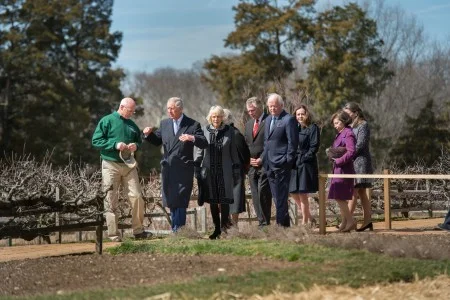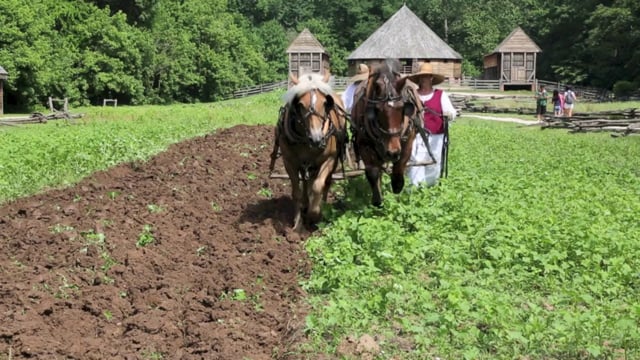You, Too, Can Follow the Route that Prince Charles Experienced
On March 18, 2015, His Royal Highness Charles, the Prince of Wales, and Her Royal Highness Camilla, the Duchess of Cornwall, visited George Washington’s Mount Vernon as part of their visit to the Washington, D.C. area.
During their stay, Their Royal Highnesses explored the heart of Mount Vernon. With this tour, you can follow in their footsteps.
Stop One: The North Lane
Exiting from their motorcade and walking towards the Mansion, their Royal Highnesses traveled down the North Lane and viewed Mount Vernon’s original outbuildings. Along this path, the royal couple passed the blacksmith shop, spinning room, the overseer’s cottage, and other interesting structures that you can visit today.
Stop Two: The Mansion
Following the North Lane, the royal couple proceeded into the Mansion for an in-depth tour of George and Martha Washington’s home. Mount Vernon first welcomed Prince Charles in 1970. During this most recent visit, he viewed the many painstakingly researched improvements that have been made to the estate over the years, including the recent restoration of the Mansion’s New Room. The Prince even managed to head up into the famous cupola atop the Mansion.
Stop Three: The East Lawn
From the east end of the New Room, the royal couple walked along the iconic Piazza and then out onto the east lawn for a breathtaking view of the Potomac River. For decades, the Mount Vernon Ladies’ Association has been active in preserving the far shore of the Potomac to ensure that the impressive view George Washington enjoyed will remain just as pristine.
"You know what was nice...going back to Mount Vernon. It was fantastic...it is special that spot..."
- Prince Charles to President Obama
Stop Four: The Kitchen
After completing their Mansion tour, Their Royal Highnesses visited Mount Vernon’s kitchen. George Washington once referred to Mount Vernon as a “well resorted tavern,” due to its constant stream of house guests and reputation for hospitality. Martha Washington oversaw the production of each meal, and this kitchen was the staging place for delicious dinners prepared with foodstuffs from Washington’s gardens, fields, and pastures. Washington’s kitchen includes three workrooms on the first floor and a loft above, which served as the residence of the cook or housekeeper.
Stop Five: The Lower Garden
From the kitchen, the Prince of Wales and the Duchess of Cornwall followed the serpentine path to the lower garden. An avid proponent of sustainable living, the Prince of Wales learned that the lower garden, one of two gardens flanking the grassy Bowling Green, has been continuously cultivated for more than 250 years. The garden features a number of beautiful vegetable beds, terraced plots, espaliered pears and apples, and brick walls designed to block the wind. The produce grown at Mount Vernon is not only used at the Mount Vernon Inn, but donated to local food pantries.
Stop Six: The Sheep Paddock
Throughout his life, Prince Charles has advocated for the preservation of heritage breeds in the United Kingdom. At Mount Vernon, we too are active in protecting historic breeds familiar to George Washington. At our sheep paddock, Their Royal Highnesses viewed our Hog Island sheep and new spring lambs. Due to the critically low numbers of this particular breed, Mount Vernon has championed their conservation. As a result, our award-winning breeding program has produced a flock of more than 70 sheep.
Stop Seven: The Tomb of Washington
George Washington died in his bedchamber at Mount Vernon on December 14, 1799. His last will outlined his desire to be buried at home at Mount Vernon. The new Tomb was completed in 1831, and the bodies of George and Martha Washington, along with other family members in the Old Tomb, were relocated here.
British royalty has had a long tradition of visiting the Tomb of George and Martha Washington. Albert Edward, Prince of Wales, son of Queen Victoria, visited the Tomb in 1860 with President James Buchanan. The future King Edward VIII in 1919 and King George VI in 1939 also laid wreaths at the Tomb.
Stop Eight: The Wharf
The majestic Potomac River was a vital part of the estate. Not only did George Washington ship and receive essential goods to and from Mount Vernon, his fisheries caught an enormous amount of herring and shad that not only fed the estate’s large enslaved population but were also sold as an export.
In 1991, Prince Charles’s mother Queen Elizabeth II dedicated the newly restored Mount Vernon wharf.
Stop Nine: The Farm
George Washington studied and implemented innovative farming methods throughout his life. In fact, Washington would have called himself a farmer before any other title. At our four-acre Farm, one can learn more about George Washington’s role as a visionary farmer. The farm also offers visitors a chance to learn more about the lives of more than one hundred enslaved field workers who put Washington’s advanced agrarian concepts into practice.
Stop Ten: The 16-Sided Treading Barn
The last stop on the Prince’s tour was a visit to the 16-sided treading barn. This recreation of Washington’s state-of-the-art wheat treading barn included a demonstration of how horses, running within the circular structure, were used to separate the wheat from the chaff. The barn includes a treading floor located on the second floor of a two-story structure that the horses could access via an earthen ramp.
Prince Charles Meets President Obama (AP)
The Prince highlights his visit to Mount Vernon with the President
Watch the video















































